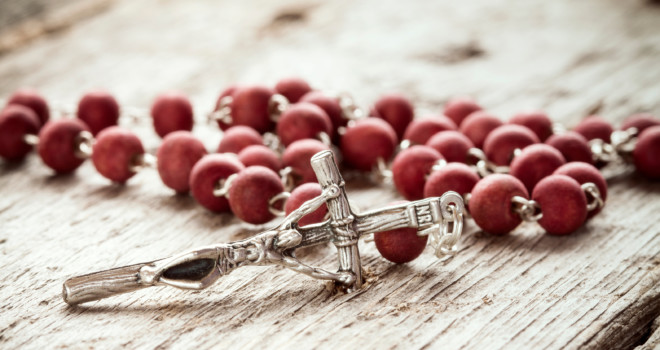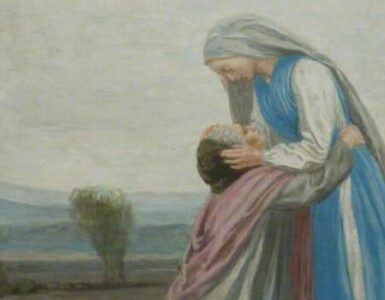
 The rosary is one of the most cherished prayers of our Catholic Church. Archbishop Fulton Sheen said, “The rosary is the book of the blind, where souls see and there enact the greatest drama of love the world has ever known; it is the book of the simple, which initiates them into mysteries and knowledge more satisfying than the education of other men; it is the book of the aged, whose eyes close upon the shadow of this world, and open on the substance of the next. The power of the rosary is beyond description.”
The rosary is one of the most cherished prayers of our Catholic Church. Archbishop Fulton Sheen said, “The rosary is the book of the blind, where souls see and there enact the greatest drama of love the world has ever known; it is the book of the simple, which initiates them into mysteries and knowledge more satisfying than the education of other men; it is the book of the aged, whose eyes close upon the shadow of this world, and open on the substance of the next. The power of the rosary is beyond description.”
Introduced by the Creed, the Our Father, three Hail Marys and the Doxology (“Glory Be”), and concluded with the Salve Regina, the rosary involves the recitation of five decades consisting of the Our Father, 10 Hail Marys, and the Doxology. During this recitation, the individual meditates on the saving mysteries of our Lord’s life and the faithful witness of our Blessed Mother. Journeying through the Joyful, Luminous, Sorrowful and Glorious mysteries of the rosary, the individual brings to mind our Lord’s incarnation, His public ministry, His passion and death, and His resurrection from the dead. In so doing, the rosary assists us in growing in a deeper appreciation of these mysteries, in uniting our lives more closely to our Lord and in imploring His graced assistance to live the faith. We also ask for the prayers of our Blessed Mother, the exemplar of faith, who leads all believers to her Son.
The origins of the rosary are “sketchy” at best. The use of “prayer beads” and the repeated recitation of prayers to aid in meditation stem from the earliest days of the Church and has roots even in pre-Christian times. Evidence exists from the Middle Ages that strings of beads were used to help a person count the number of Our Fathers or Hail Marys recited. Actually, these strings of beads became known as Paternosters, the Latin for “Our Father.” For example, in the 12th century, to help the uneducated better participate in the liturgy, the recitation of 150 Our Fathers served as a substitute for the 150 Psalms, and became known as “the poor man’s breviary.”
The structure of the rosary gradually evolved between the 12th and 15th centuries. Eventually 50 Hail Marys (or more) were recited and were linked with verses of psalms or other phrases evoking “the joys of Mary,” i.e. scenes in the lives of Jesus and Mary. In 1409 Dominic of Prussia, a Carthusian monk, popularized the practice setting 50 phrases about the lives of Jesus and Mary with 50 Hail Marys. During this time, this prayer form became known as the rosarium (“rose garden”), actually a common term used to designate a collection of similar material, such as an anthology of stories on the same subject or theme. Eventually, “the sorrows of Mary” and “the heavenly joys” were distinguished, bringing the number of Hail Marys to 150. Eventually, the 150 Hail Marys were joined to the 150 Our Fathers, a Hail Mary following each Our Father.
In the early 15th century, Henry Kalkar (d. 1408), another Carthusian, divided the 150 Hail Marys into groups of 10, with each group marked by an Our Father. By the 16th century, the structure of the five-decade rosary was based on the three sets of mysteries — joyful (Annunciation, Visitation, Nativity, Presentation and Finding in the Temple), sorrowful (Agony in the Garden, Scourging, Crowning with Thorns, Carrying of the Cross and Death) and glorious (Resurrection, Ascension, Pentecost, Assumption and Coronation). In 2002, our beloved late Holy Father, Pope John Paul II, instituted the luminous mysteries: Baptism at the Jordan, Wedding Feast of Cana, Proclamation of the Kingdom of God, Transfiguration and Institution of the holy Eucharist. Also, after the apparitions of Our Lady at Fatima in 1917, the prayer Mary taught to the children has generally been added at the end of each decade: “O my Jesus, forgive us our sins, save us from the fires of hell. Lead all souls to heaven, especially those in greatest need of Thy mercy.”
Tradition does hold that St. Dominic (d. 1221) devised the rosary as we know it. Moved by a vision of our Blessed Mother, he preached the use of the rosary in his missionary work among the Albigensians, a group of fanatical heretics. The Albigensians, named after the town of Albi in southern France where they lived, believed that everything material was evil and everything spiritual was good. For this reason, they denied the incarnation of our Lord; for them, Jesus the true God becoming also true man and accepting our human nature was simply unthinkable. Following this teaching, each person’s soul was imprisoned in the evil body. Therefore, they abstained from marital love, because no one should imprison another soul in a body. Their greatest act of religion was called “the endura,” an act of suicide which freed the soul from the body. They also fought against any authority that represented a kingdom of this world, assassinating royal and Church officials alike. The Church condemned these heretics, and St. Dominic tried to convert them through reasonable preaching and genuine Christian love. Unfortunately, royal authority was less compassionate. (Just as an aside, a travel show televised a program on southern France, and visited the town of Albi, noting that these people were “persecuted by the Church”; the narrator failed to report that these people were suicidal heretics whose teachings jeopardized the souls of the faithful.) Nevertheless, St. Dominic used the rosary as a useful instrument to convert the Albigensians.
Some scholars take exception to St. Dominic’s actual role in forming the rosary since the earliest accounts of his life do not mention it, the Dominican constitutions do not link him with it, and contemporaneous paintings of St. Dominic do not include it as a symbol to identify the saint. In 1922, Dom Louis Gougaud stated, “The various elements which enter into the composition of that Catholic devotion commonly called the rosary are the product of a long and gradual development which began before St. Dominic’s time, which continued without his having any share in it, and which only attained its final shape several centuries after his death.” However, other scholars would argue that St. Dominic not so much “invented” the rosary as he preached its use to convert sinners and those who had strayed from the Faith. Moreover, at least a dozen popes have mentioned St. Dominic’s connection with the rosary in various papal pronouncements, sanctioning his role as at least a “pious belief.” The first such mention was made by Pope Alexander VI in 1495.
Editor’s note: This article courtesy of the Arlington Catholic Herald.













